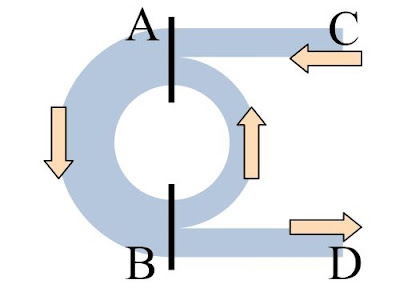In this article, we describe money circulation in a fluid sense.
The figure below shows a waterway of money circulation. We expect that this attempt help scientists and engineers, who are familiar with fluid-dynamics and electronic circuits, understand the money circulation. It is easier to understand temporal evolution of money circulation via this image.
 |
| A fluid-like money circulation. |
1. Fluid-like money circulation
For our fluid sense, we assumed that monetary flow is an incompressible fluid.
In the above figure, arrows shows the direction of the money flow. The cross section of `A' means the goods and services market, the cross section of `B' means the household budget, and `C' and `D' mean government and financial market.
In this ideal flow path, two money flows merges at `A', and one flow separates into two flows at `B'. Two flows have a certain ratio. This ratio is the average propensity to consume of households. The two flow toward `A' are for consumption, and the flow toward `D' is for tax and savings.
Let us consider its temporal variation. When the flow from `C' increases, the whole flow increases. And when the flow from `C' decreases, the whole flow naturally decreases. When the flow from `C' does not change, and when the average propensity to consume of households change, the whole flow gradually close to the new steady state.
Nominal GDP is the time integrated value of the money flow measured at some cross section from `A' to `B'. At `A', it means the total amount of goods and services sold by the company. And at `B', it means the total income of all households.
Our original article in Japanese, '【貨幣循環】流体的貨幣循環と直接給付とインフレターゲット'
Link page: Contents for money circulation




No comments:
Post a Comment